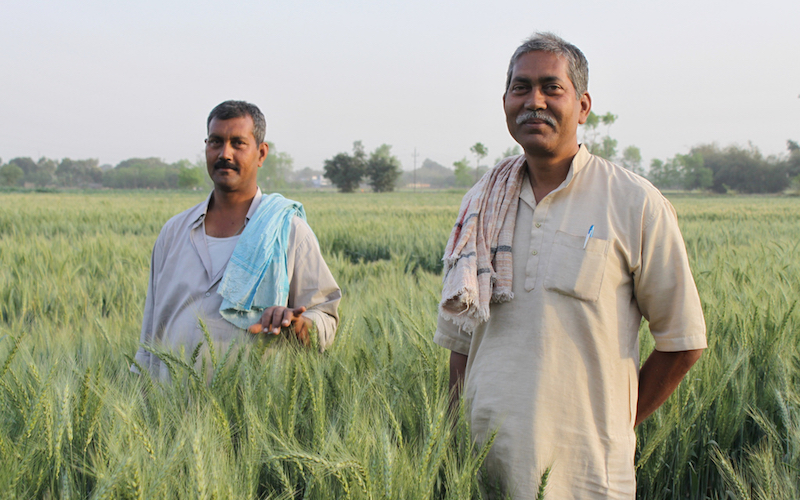
Climate Change and Indian Agriculture
Climate change is any significant long-term change in the expected patterns of average weather of a region (or the whole Earth) over a significant period of time. It is about abnormal variations to the climate, and the effects of these variations on other parts of the earth. These changes may take tens, hundreds or perhaps millions of years. But increased anthropogenic activities such as industrialization, urbanization, deforestation, agriculture, change in land use pattern etc. lead to emission of greenhouse gases due to which the rate of climate change is much faster.
Climate change scenarios include higher temperatures, changes in precipitation, and higher atmospheric CO2 concentrations. There are three ways in which the “Greenhouse Effect” may be important for agriculture. First, increased atmospheric CO2 concentrations can have a direct effect on the growth rate of crops. Secondly, CO2-induced changes of climate may alter levels of temperature, rainfall and sunshine that can influence plant and animal productivity. Finally, rises in sea level may lead to loss of farmland by inundation and increasing salinity of groundwater in coastal areas.
India’s agriculture
From ancient times India’s agriculture has been dependent on monsoons. Any change in monsoon trends drastically affects agriculture. Even the increasing temperature is affecting Indian agriculture. In the Indo-Gangetic Plain, these pre-monsoon changes will primarily affect the wheat crop (>0.5oC increase in time slice 2010-2039; IPCC 2007). In the states of Jharkhand, Odisha and Chhattisgarh alone, rice production losses during severe droughts (about one year in five) average about 40 percent of total production, with an estimated value of $800 million.
Increase in CO2 to 550 ppm increases yields of rice, wheat, legumes and oilseeds by 10 to 20 percent. A 1oC increase in temperature may reduce yields of wheat, soybeans, mustards, groundnuts, and potatoes by 3 to 7 percent. There would be higher losses at higher temperatures. Productivity of most crops decreases only marginally by 2020 but by 10 to 40 percent by 2100 due to increases in temperature, rainfall variability, and decreases in irrigation water.
The major impacts of climate change will be on rain fed or un-irrigated crops, which are cultivated on nearly 60 percent of cropland. A temperature rise by 0.5oC in winter temperature is projected to reduce rain fed wheat yield by 0.45 tonnes per hectare. Possibly there might be some improvement in yields of chickpeas, rabi maize, sorghum and millets and coconut on the west coast and less loss in potatoes, mustard and vegetables in north-western India due to reduced frost damage. Increased droughts and floods are likely to increase production variability.
Recent studies done at the Indian Agricultural Research Institute indicate the possibility of a loss of between 4 and 5 million tons in wheat production in the future with every rise of 1oC temperature throughout the growing period. Rice production is slated to decrease by almost a tonne/hectare if the temperature rises by 2 degree celsius. In Rajasthan, a 2 degree rise in temperature was estimated to reduce production of pearl millet by 10 to 15 percent. If maximum and minimum temperatures rise by 3 and 3.5 degrees respectively, then soya bean yields in M.P will decline by 5 percent compared to 1998. Agriculture will be affected in the coastal regions of Gujarat and Maharashtra, as fertile areas are vulnerable to inundation and salinization.
Food security
Food security is both directly and indirectly linked with climate change. Any alteration in the climatic parameters such as temperature and humidity which govern crop growth will have a direct impact on quantity of food produced. Indirect linkage pertains to catastrophic events such as floods and droughts which are projected to multiply as a consequence of climate change leading to huge crop loss and leaving large patches of arable land unfit for cultivation which hence threatens food security. The net impact of food security will depend on the exposure to global environmental change and the capacity to cope with and recover from global environmental changes. On a global level, increasingly unpredictable weather patterns will lead to a fall in agricultural production and higher food prices, leading to food insecurity.
Food insecurity could be an indicator for assessing vulnerability to extreme events and slow-onset changes. This impact of global warming has significant consequences for agricultural production and trade of developing countries as well as an increased risk of hunger. The number of people suffering from chronic hunger has increased from under 800 million in 1996 to over 1 billion recently. United Nations population data and projections show the global population reaching 9.1 billion by 2050, an increase of 32 percent from 2010.
The world’s population is expected to grow by 2.2 billion in the next 40 years, and a significant portion of the additional population will be in countries that have difficulties feeding themselves. Preliminary estimates for the period up to 2080 suggest a decline of some 15 to 30 percent of agricultural productivity in the most climate-change-exposed developing country regions – Africa and South Asia. Even the IPCC, scarcely alarmist, says a 0.5 degree rise in winter temperature would reduce wheat yield by 0.45 tons per hectare in India. Rice and wheat have an important share in total food grain production in India. Any change in rice and wheat yields may have a significant impact on food security of the country. And this when Indian agriculture is already in crisis, and in the last twenty years 300,000 farmers have killed themselves.
Adaption
In view of drastic environmental changes taking place it is necessary for farmers as well as for the Indian government to adapt to changing situation as soon as possible.
The Indian government should assist farmers in coping with current climatic risks by providing value-added weather services to farmers. Farmers can adapt to climate changes to some degree by shifting planting dates, choosing varieties with different growth duration, or changing crop rotations. An Early warning system should be put in place to monitor changes in pest and disease outbreaks. The overall pest control strategy should be based on integrated pest management because it takes care of multiple pests in a given climatic scenario. Developing short-duration crop varieties that can mature before the peak heat phase set in.
Farmers should select genotype in crops that have a higher per day yield potential to counter yield loss from heat-induced reduction in growing periods. Preventive measures for drought that include on-farm reservoirs in medium lands, growing of pulses and oilseeds instead of rice in uplands, ridges and furrow system in cotton crops, growing of intercrops in place of pure crops in uplands, land grading and leveling, stabilization of field bunds by stone and grasses, graded line bunds, contour trenching for runoff collection, conservation furrows, mulching and more application of Farm yard manure (FYM). Efficient water use such as frequent but shallow irrigation, drip and sprinkler irrigation for high value crops, irrigation at critical stages.
They should emphasize on efficient use of fertilizer such as optimum fertilizer dose, split application of nitrogenous and potassium fertilizers, deep placement, use of neem, karan products and other such nitrification inhibitors, liming of acid soils, use of micronutrients such as zinc and boron, use of sulphur in oilseed crops, integrated nutrient management. Seasonal weather forecasts could be used as a supportive measure to optimize planting and irrigation patterns. Provide greater coverage of weather linked agriculture insurance.
Finally…
“Global Warming” has now started showing its impacts worldwide. Climate is the primary determinant of agricultural productivity which directly impacts food production across the globe. The agriculture sector is the most sensitive sector to climate changes because the climate of a region/country determines the nature and characteristics of vegetation and crops. Increase in the mean seasonal temperature can reduce the duration of many crops and hence reduce final yield. Food production systems are extremely sensitive to climate changes like changes in temperature and precipitation, which may lead to outbreaks of pests and diseases thereby reducing harvest ultimately affecting the food security of the country.
The net impact of food security will depend on the exposure to global environmental change and the capacity to cope with and recover from global environmental change. Coping with the impact of climate change on agriculture will require careful management of resources like soil, water and biodiversity. To cope with the impact of climate change on agriculture and food production, India will need to act at the global, regional, national and local level.

